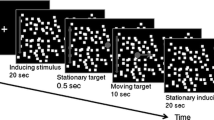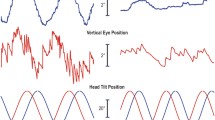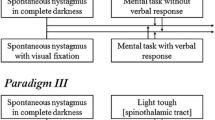Summary
Horizontal and vertical eye movements were recorded from cats in response to either a) off-vertical axis rotation (OVAR) at a range of velocities (5–72 deg/s) and a range of tilts (0–60 deg) or b) horizontal (with respect to the cat) optokinetic stimulation (10–80 deg/s), also around a range of tilted axes (0–60 deg). The responses to stopping either of these stimuli were also measured: post-rotatory nystagmus (PRN) following actual rotation, and optokinetic after nystagmus (OKAN) following optokinetic stimulation. The response found during OVAR was a nystagmus with a bias slow-phase velocity that was sinusoidally modulated. The bias was dependent on the tilt and reached 50% of its maximum velocity (maximum was 73±23% of the table velocity) at a tilt of 16 deg. The phase of modulation in horizontal eye velocity bore no consistent relation to the angular rotation. The amplitude of this modulation was roughly correlated with the bias with a slope of 0.13 (deg/s) modulation/(deg/s) bias velocity. There was also a low-velocity vertical bias with the slow-phases upwardly directed. The vertical bias was also modulated and the amplitude depended on the bias velocity (0.27 (deg/s) modulation/ (deg/s) bias velocity). When separated from the canal dependent response, the build up of the OVAR response had a time constant of 5.0±0.8 s. Following OVAR there was no decline in the time constant of PRN which remained at the value measured during earth-vertical axis rotation (EVAR) (6.3±2 s). The peak amplitude of PRN was reduced, dependent on the tilt, reaching only 20% of its EVAR value for a tilt of 20 deg. When a measurable PRN was found, it was accompanied by a slowly-emerging vertical component (time constant 5.4±2s) the effect of which was to vector the PRN accurately onto the earth horizontal. OKN measured about a tilted axis showed no differences in magnitude or direction from EVAR OKN even for tilts as large as 60 deg. OKAN following optokinetic stimulation around a tilted axis appeared normal in the horizontal plane (with respect to the animal) but was accompanied by a slowly emerging (time constant 4.1±2 s) vertical component, the effect of which was to vector the overall OKAN response onto the earth horizontal for tilts less than 20 deg. These results are compared with data from monkey and man and discussed in terms of the involvement of the velocity storage mechanism.
Similar content being viewed by others
References
Andersen JH (1981) Ocular torsion in the cat after lesions of the interstitial nucleus of Cajal. Ann New York Acad Sci 374: 865–872
Benson AJ, Bodin MA (1966a) Interaction of linear and angular accelerations on vestibular receptors in man. Aerosp Med 37: 144–154
Benson AJ, Bodin MA (1966b) Comparison of the effect of the direct of gravitational acceleration on postrotational responses in yaw, pitch and roll. Aerosp Med 37: 889–897
Blanks RHI, Curthoys IS, Markham CH (1972) Planar relationships of semicircular canals in the cat. Am J Physiol 223: 55–62
Cohen B, Suzuki J, Raphan T (1983) Role of the otolith organs in generation of horizontal nystagmus; effect of selective labyrinthine lesions. Brain Res 276: 159–164
Correia MJ, Guedry FE (1966) Modification of vestibular response as a function of the rate of rotation about an earth horizontal axis. Acta Oto-Laryngol 62: 297–308
Correia MJ, Money KE (1970) The effect of blockage of all six semicircular canal ducts on nystagmus produced by dynamic linear acceleration in the cat. Acta Otolaryngol 69: 7–16
Darlot C, Cohen B, Berthoz A, Denise P, Freyss G (1985) Perceptual and oculomotor effects of off-vertical axis rotation (OVAR) at small angles of tilt. Int Mtng Barany Society, Ann Arbor (in press)
Demer JL (1981) The variable gain element of the vestibulo-ocular reflex is common to the optokinetic system of the cat. Brain Res 229: 1–13
Denise P, Darlot C (1985) Steady-state and dynamic characteristics of eye movements in cats during off vertical axis rotation. Neurosci Lett 22 Suppl S483
Evinger C, Fuchs AF (1978) Saccadic smooth pursuit and optokinetic eye movements in the trained cat. J Physiol (Lond) 285: 209–229
Goldberg JM, Fernandez C (1982) Eye movements and vestibular-nerve responses produced in the squirrel monkey by rotations about an earth-horizontal axis. Exp Brain Res 46: 393–402
Hain TC (1986) A model of the nystagmus induced by off vertical axis rotation. Biol Cybern 54: 337–350
Harris LR (1986a) The effect of opposing canal and otolith signals during off-vertical-axis rotation in the cat. J Physiol (Lond) 371: 30P
Harris LR (1986b) Adaptation of the vestibulo-ocular reflex does not affect the response to off-vertical-axis rotation in the cat. J Physiol (Lond) 382: 78P
Harris LR, Barnes GB (1985) The orientation of vestibular nystagmus is modified by head tilt. Int Mtng Barany Society, Ann Arbor (in press)
Harris LR, Cynader MS (1981a) The eye movements of the dark-reared cat. Exp Brain Res 44: 41–56
Harris LR, Cynader MS (1981b) Modification of the balance and gain of the vestibulo-ocular reflex in the cat. Exp Brain Res 44: 57–70
Jäger J, Henn V (1981) Habituation of the vestibulo-ocular reflex (VOR) in the monkey during sinusoidal rotation in the dark. Exp Brain Res 41: 108–114
Judge SJ, Richmond BJ, Chu FC (1980) Implantation of magnetic search coils for measurement of eye position: an improved method. Vision Res 20: 535–538
Maioli C, Precht W (1984) The horizontal optokinetic nystagmus in the cat. Exp Brain Res 55: 494–506
Maioli C, Precht W, Ried S (1983) Short- and long-term modifications of the vestibulo-ocular response dynamics following unilateral vestibular nerve lesions in the cat. Exp Brain Res 50: 259–274
Raphan T, Cohen B (1983) Gravitational effects on visual vestibule-oculomotor coordinate transformations generating compensatory eye movements. Soc Neurosci Abstr 13: 316
Raphan T, Cohen B (1985) Velocity storage and the ocular response to multidimensional vestibular stimuli. In: Berthoz A, Melvill Jones G (eds) Adaptive mechanisms in gaze control. Elsevier, North Holland, pp 123–144
Raphan T, Cohen B, Henn V (1981) Effects of gravity on rotatory nystagmus in monkeys. Ann NY Acad Sci 374: 44–55
Raphan T, Matsuo V, Cohen B (1979) Velocity storage in the vestibulo-ocular reflex arc (VOR). Exp Brain Res 35: 229–248
Raphan T, Waespe W, Cohen B (1983) Labyrinthine activation during rotation about axes tilted from the vertical. Adv Otorhinolaryngol 30: 50–53
Robinson DA (1963) A method of measuring eye movement using a scleral search coil in a magnetic field. IEEE Trans Bio Med Elect BME-10: 137–145
Robinson DA (1976) Adaptive gain control of the vestibulo-ocular reflex by the cerebellum. J Neurophysiol 39: 954–969
Robinson DA (1982) The use of matrices in analyzing the three-dimensional behavior of the vestibulo-ocular reflex. Biol Cybern 46: 53–66
Robinson DA (1985) The coordinates in the vestibulo-ocular reflex. In: Berthoz A, Melvill Jones G (eds) Adaptive mechanisms in gaze control. Elsevier, North Holland, pp 297–312
Takahashi M, Igarashi M, Homick JL (1977) Effect of otolith end organ ablation on horizontal optokinetic nystagmus and optokinetic afternystagmus in the squirrel monkey. ORL 39: 74–81
Young LR, Henn V (1975) Nystagmus produced by pitch and yaw rotation of monkeys. Fortschr Zool 23: 235–246
Author information
Authors and Affiliations
Rights and permissions
About this article
Cite this article
Harris, L.R. Vestibular and optokinetic eye movements evoked in the cat by rotation about a tilted axis. Exp Brain Res 66, 522–532 (1987). https://doi.org/10.1007/BF00270685
Received:
Accepted:
Issue Date:
DOI: https://doi.org/10.1007/BF00270685




